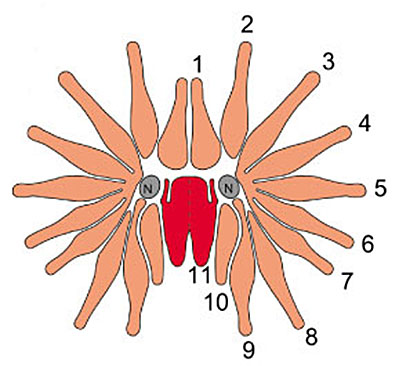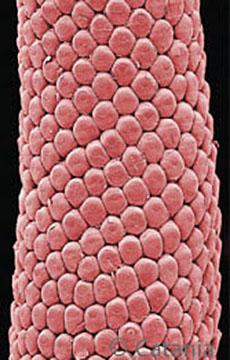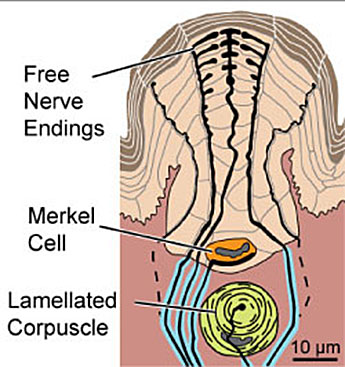 |
Star-nosed moles (Condylura cristata) have extraordinary specializations that make them a useful model system for understanding how touch is represented in the neocortex and for investigating the evolution of mammalian brains and behaviors. Several key features of this animal’s sensory system are listed and then briefly described below.
1) Densely innervated nose with 25,000 touch organs
2) A somatosensory (touch) fovea on the star.
3) Visible brains maps in the neocortex.
4) The fastest mammalian sensory discriminations.
5) The ability to sniff while diving underwater.
Click for Video of High-Speed Behavior
Click for Video of Underwater Sniffing |
 |
The 22 nasal rays of the star-nosed mole (11 on each side) are shown schematically on the left. The central, highlighted pair acts as the touch “fovea.” In a manner analogous to the retinal fovea in visual systems, the 11th rays are used for detailed investigations of objects through touch. Moles can identify and eat a small prey item in as little as 120 milliseconds, placing them in the Guinness Book of World Records as the fastest mammalian forager. |
 |
The image on the left shows a single nasal ray under the scanning electron microscope. The rays are completely covered with domed touch papillae called Eimer’s organs. There are 25,000 organs on a single star innervated by 100,000 myelinated nerve fibers. The image to the right shows the internal structure of a single Eimer’s organ and the associated mechanoreceptors. |
 |
| When properly sectioned and stained the neocortical map of the star can be seen as a series of dark stripes (Right bottom). Each stripe is the representation of a nasal ray from the opposite side of the star (Right top). Notice the 11th stripe in the brain map is much larger than would be expected from the size of the 11th ray. This enlargement of the tactile fovea reflects its importance, much as the retinal fovea has a large representation in visual cortex. |
 |
 |
When diving underwater in search of prey, star-nosed moles exhale air bubbles through their nostrils. These bubbles spread over objects they are exploring, allowing them to collect odorants. Using this strategy a mole can follow an underwater scent trail. This ability came as a surprise, as it was previously believed that olfaction could not be used underwater. |
Click here for a recent review of these and other results.






